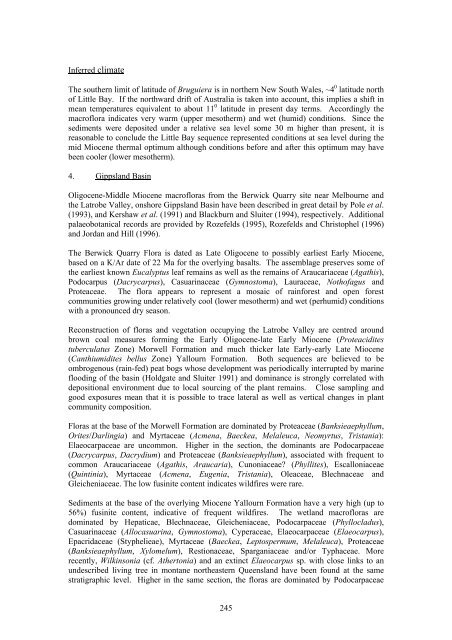OFR 151.pdf - CRC LEME
OFR 151.pdf - CRC LEME
OFR 151.pdf - CRC LEME
Create successful ePaper yourself
Turn your PDF publications into a flip-book with our unique Google optimized e-Paper software.
Inferred climate<br />
The southern limit of latitude of Bruguiera is in northern New South Wales, ~4 0 latitude north<br />
of Little Bay. If the northward drift of Australia is taken into account, this implies a shift in<br />
mean temperatures equivalent to about 11 0 latitude in present day terms. Accordingly the<br />
macroflora indicates very warm (upper mesotherm) and wet (humid) conditions. Since the<br />
sediments were deposited under a relative sea level some 30 m higher than present, it is<br />
reasonable to conclude the Little Bay sequence represented conditions at sea level during the<br />
mid Miocene thermal optimum although conditions before and after this optimum may have<br />
been cooler (lower mesotherm).<br />
4. Gippsland Basin<br />
Oligocene-Middle Miocene macrofloras from the Berwick Quarry site near Melbourne and<br />
the Latrobe Valley, onshore Gippsland Basin have been described in great detail by Pole et al.<br />
(1993), and Kershaw et al. (1991) and Blackburn and Sluiter (1994), respectively. Additional<br />
palaeobotanical records are provided by Rozefelds (1995), Rozefelds and Christophel (1996)<br />
and Jordan and Hill (1996).<br />
The Berwick Quarry Flora is dated as Late Oligocene to possibly earliest Early Miocene,<br />
based on a K/Ar date of 22 Ma for the overlying basalts. The assemblage preserves some of<br />
the earliest known Eucalyptus leaf remains as well as the remains of Araucariaceae (Agathis),<br />
Podocarpus (Dacrycarpus), Casuarinaceae (Gymnostoma), Lauraceae, Nothofagus and<br />
Proteaceae. The flora appears to represent a mosaic of rainforest and open forest<br />
communities growing under relatively cool (lower mesotherm) and wet (perhumid) conditions<br />
with a pronounced dry season.<br />
Reconstruction of floras and vegetation occupying the Latrobe Valley are centred around<br />
brown coal measures forming the Early Oligocene-late Early Miocene (Proteacidites<br />
tuberculatus Zone) Morwell Formation and much thicker late Early-early Late Miocene<br />
(Canthiumidites bellus Zone) Yallourn Formation. Both sequences are believed to be<br />
ombrogenous (rain-fed) peat bogs whose development was periodically interrupted by marine<br />
flooding of the basin (Holdgate and Sluiter 1991) and dominance is strongly correlated with<br />
depositional environment due to local sourcing of the plant remains. Close sampling and<br />
good exposures mean that it is possible to trace lateral as well as vertical changes in plant<br />
community composition.<br />
Floras at the base of the Morwell Formation are dominated by Proteaceae (Banksieaephyllum,<br />
Orites/Darlingia) and Myrtaceae (Acmena, Baeckea, Melaleuca, Neomyrtus, Tristania):<br />
Elaeocarpaceae are uncommon. Higher in the section, the dominants are Podocarpaceae<br />
(Dacrycarpus, Dacrydium) and Proteaceae (Banksieaephyllum), associated with frequent to<br />
common Araucariaceae (Agathis, Araucaria), Cunoniaceae? (Phyllites), Escalloniaceae<br />
(Quintinia), Myrtaceae (Acmena, Eugenia, Tristania), Oleaceae, Blechnaceae and<br />
Gleicheniaceae. The low fusinite content indicates wildfires were rare.<br />
Sediments at the base of the overlying Miocene Yallourn Formation have a very high (up to<br />
56%) fusinite content, indicative of frequent wildfires. The wetland macrofloras are<br />
dominated by Hepaticae, Blechnaceae, Gleicheniaceae, Podocarpaceae (Phyllocladus),<br />
Casuarinaceae (Allocasuarina, Gymnostoma), Cyperaceae, Elaeocarpaceae (Elaeocarpus),<br />
Epacridaceae (Styphelieae), Myrtaceae (Baeckea, Leptospermum, Melaleuca), Proteaceae<br />
(Banksieaephyllum, Xylomelum), Restionaceae, Sparganiaceae and/or Typhaceae. More<br />
recently, Wilkinsonia (cf. Athertonia) and an extinct Elaeocarpus sp. with close links to an<br />
undescribed living tree in montane northeastern Queensland have been found at the same<br />
stratigraphic level. Higher in the same section, the floras are dominated by Podocarpaceae<br />
245

















